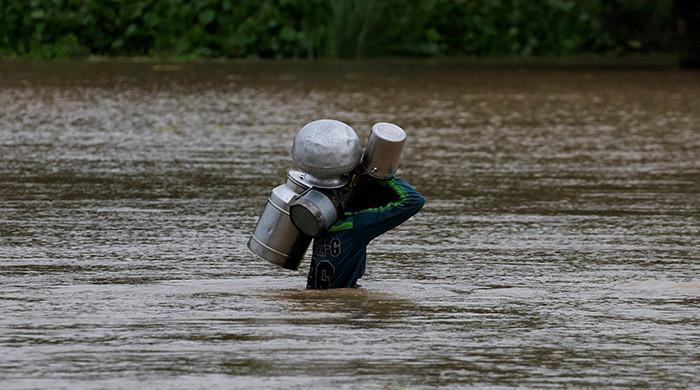Massive Evacuations Underway as Sutlej and Ravi Rivers Swell
Following alerts issued by the National Disaster Management Authority (NDMA) concerning rising water levels in the Sutlej and Ravi rivers, approximately 150,000 individuals have been moved to safer locations. This action follows substantial rainfall and the release of water into the rivers from India.
Authorities have issued warnings about potential inundation in adjacent districts as the rivers continue to expand.
The Provincial Disaster Management Authority (PDMA) in Punjab, acting on these early warnings, has initiated removal operations in susceptible areas, relocating numerous residents from Bahawalnagar, Kasur, Okara, Pakpattan, Bahawalpur, and Vehari.
According to the NDMA, about 40,000 people had independently moved away from the danger zones shortly after the initial advisories were released. Emergency teams have been strategically positioned, and all pertinent departments have been placed on high alert to protect people and possessions.
Citizens are strongly encouraged to avoid rivers, streams, and low-lying areas, to abstain from unnecessary journeys, and to carefully adhere to safety guidelines disseminated through various channels, including television, radio, mobile alerts, and the Pak NDMA Disaster Alert app.
Punjab Chief Minister Maryam Nawaz Sharif instructed officials on Monday to expedite the evacuation of individuals affected by the approaching floodwaters.
The NDMA reports that the flood situation in major rivers remains crucial. The Sutlej River has reached a very high flood stage in certain areas, while other parts of the river are experiencing high to medium-level flooding.
The Ravi River is also experiencing increasing water levels, with medium flooding in some areas and lower levels in others. Its tributaries, including Basantar, Bein, and Deg, are also experiencing low to medium flood conditions. The Indus River is facing medium flooding at Sukkur and low flooding at Kalabagh, Chashma, Guddu, and Kotri barrages.
The Chenab River has entered a low flood stage at Head Marala, and its tributaries are also seeing low water levels. Water flow in the Jhelum, Kabul, and Nari rivers is normal, and hill torrents in the Suleman Range and Dera Ghazi Khan division are presently inactive.
Additionally, reservoirs are filling up, with Tarbela nearing full capacity and Mangla approaching its limit. Khanpur, Rawal, and Simly dams are also registering increased water levels.
Punjab authorities have directed deputy commissioners and commissioners in Lahore, Sahiwal, Multan, Bahawalpur, and Dera Ghazi Khan to maintain vigilance. Announcements are being broadcast via mosques, urging residents to evacuate to safe locations. Relief camps and fodder arrangements have been established for displaced families and their livestock.
These warnings come after New Delhi made two formal communications this week to inform Islamabad about planned water discharges. India’s Madhopur Headworks has already increased inflows into the Ravi, and water released into the Sutlej has submerged sections of southern Punjab.
The NDMA has advised that substantial rainfall forecast across Indian states, including Himachal Pradesh and Uttarakhand, could further inflate rivers and streams flowing toward Pakistan. The National Emergency Operations Centre is continuously monitoring the situation.
Sources indicate that the Indian High Commission in Islamabad communicated the alerts to Pakistan’s Foreign Ministry on “humanitarian grounds,” instead of through the Indus Waters Commission as stipulated by the Indus Waters Treaty (IWT). This development was unexpected, especially after New Delhi declared in April that it was placing the long-standing treaty in “abeyance” following an incident involving tourists in Indian Illegally Occupied Jammu and Kashmir (IIOJK) — an allegation Pakistan denies.
India’s recent decision to suspend the treaty strained relations between the two countries, culminating in a serious military altercation in May, before a ceasefire mediated by the US.
News agencies report that Delhi is also contemplating initiatives that could decrease flows into Pakistan, raising concerns in Islamabad.
Heavy rains in IIOJK have resulted in at least 60 fatalities this month, while almost 400 have perished in northwestern Pakistan. Cumulatively, the floods have claimed 799 lives nationwide since the monsoon season commenced in late June, according to the NDMA, which has cautioned about additional heavy rainfall expected until September 10.
The Foreign Office stated on Monday that India’s declaration to hold the treaty in abeyance “constitutes a serious violation of international law” that could impact regional peace and stability. It emphasized India’s obligation to fully adhere to the IWT’s stipulations.
The Indus Waters Treaty, brokered by the World Bank and ratified in 1960, oversees water distribution between the two nations. The agreement assigned the three eastern rivers — Sutlej, Beas, and Ravi — to India, while granting Pakistan command over the three western rivers — Indus, Jhelum, and Chenab.
The treaty lacks provisions for either country to unilaterally suspend or nullify the agreement, which includes conflict resolution mechanisms.
Pakistan is concerned that India may disrupt its primary water supply, threatening agriculture and hydropower. New Delhi has asserted that it will not reinstate the treaty unless Islamabad ceases support for cross-border militancy.



Comments (0)
No comments yet. Be the first to comment!
Leave a Comment